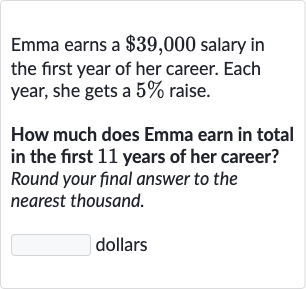Full solution
Q. Emma earns a salary in the first year of her career. Each year, she gets a raise.How much does Emma earn in total in the first years of her career? Round your final answer to the nearest thousand.dollars
- Initial salary and raise percentage: Emma earns a salary in the first year of her career. Each year, she gets a raise. To find out how much Emma earns in total in the first years of her career, we need to calculate the sum of a geometric series where the first term is her initial salary and the common ratio is the annual raise percentage converted to a multiplier.
- Formula for calculating the sum of a geometric series: The first term of the geometric series is her initial salary, which is . The common ratio is plus the raise percentage expressed as a decimal. Since the raise is , the common ratio is .
- Substituting values into the formula: The sum of the first terms of a geometric series can be calculated using the formula , where is the sum of the first terms, is the first term, is the common ratio, and is the number of terms. In this case, is because we are looking at the first years of her career.
- Calculating the value of : Substitute the known values into the formula to calculate the total earnings over the years: .
- Calculating the numerator: Calculate the sum: . First, calculate the value of .
- Calculating the denominator: is approximately . Now substitute this value back into the sum formula: .
- Finding the sum: Calculate the numerator: . This is a negative number because we subtracted a number greater than from , which represents the total growth factor over years.
- Rounding the final answer: Now calculate the denominator: . This is also a negative number, representing the growth factor per year subtracted from .
- Rounding the final answer: Now calculate the denominator: . This is also a negative number, representing the growth factor per year subtracted from .Divide the numerator by the denominator to find the sum: .
- Rounding the final answer: Now calculate the denominator: . This is also a negative number, representing the growth factor per year subtracted from .Divide the numerator by the denominator to find the sum: .Round the final answer to the nearest thousand: $S_{\(11\)} \approx \$(\(554\),\(000\)).
More problems from Exponential growth and decay: word problems
QuestionGet tutor help
QuestionGet tutor help
QuestionGet tutor help
QuestionGet tutor help
QuestionGet tutor help
QuestionGet tutor help
QuestionGet tutor help
QuestionGet tutor help
QuestionGet tutor help

